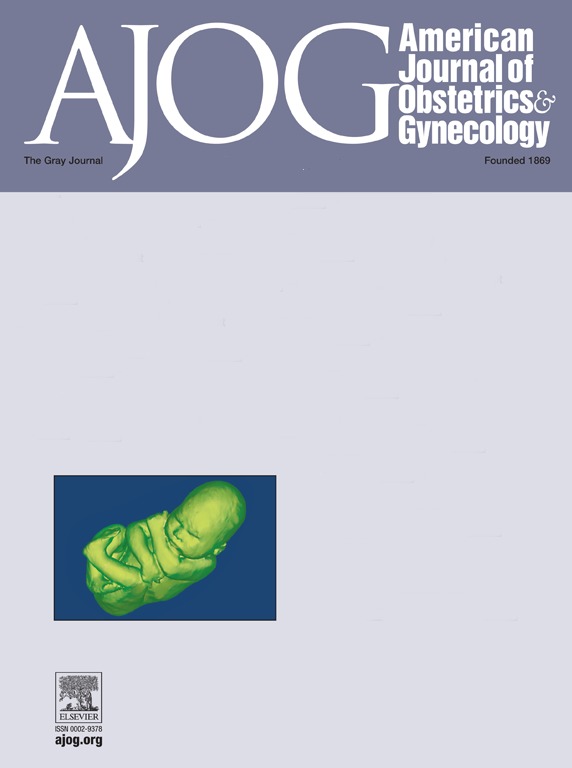左炔诺孕酮宫内系统vs宫腔镜小位切除术治疗月经后点滴:一项为期三年的随机随访试验。
IF 8.4
1区 医学
Q1 OBSTETRICS & GYNECOLOGY
引用次数: 0
摘要
目的:基于先前的研究结果,52 mg左炔诺孕酮宫内系统(LNG-IUS)和宫腔镜生态位切除均可显著减少生态位相关的月经后点滴,超过70%的患者在6个月时减少≥50%,LNG-IUS在9个月后表现出卓越的疗效,本研究评估两种治疗在36个月以上减少生态位相关的月经后点滴的长期有效性。研究设计:这项为期三年的随访来自一项单中心随机试验。剖宫产后出现经后点滴,磁共振成像(MRI)证实微位深度≥2.0 mm,残留肌层≥2.2 mm,一年内无怀孕计划的女性随机接受52 mg LNG-IUS或宫腔镜微位切除术。这项长期随访的主要结果是36个月时点滴发生率较基线降低≥50%的女性比例。次要结果包括月经模式、点滴不适、慢性盆腔疼痛和治疗满意度,分别在18、24、30和36个月进行评估。结果共纳入208例(每组104例),其中LNG-IUS组93例(89.4%),宫腔镜生态位切除术组89例(85.6%)完成了3年随访。36个月时,LNG-IUS组98.9%的妇女和宫腔镜组51.7%的妇女的点滴发生率减少了50% (RR, 1.91 [95% CI, 1.56 - 2.34]; p < 0.001)。LNG-IUS组在36个月时点滴发生率逐渐下降(p趋势= 0.001),而宫腔镜组在24个月时点滴发生率下降(p=0.007),随后略有上升。观察到显著的时间-治疗相互作用(p = 0.007), LNG-IUS组在24个月后表现出更好的点滴减少。此外,LNG-IUS组在6个月后出现更少的月经后点滴天数、总出血天数(p < 0.001)和更少的盆腔疼痛(p < 0.010),差异随着时间的推移而扩大。在随访期间,LNG-IUS组中有20名女性报告了激素相关的副作用,其中2名出现了部分排尿。结论:在36个月以上,52 mg LNG-IUS在减少经后点滴、盆腔疼痛和不适方面优于宫腔镜生态位切除术,同时对有症状性生态位的妇女也有避孕益处。我们推荐LNG-IUS作为至少明年没有生育欲望的育龄妇女与生态位相关的点滴的一线治疗。本文章由计算机程序翻译,如有差异,请以英文原文为准。
Levonorgestrel intrauterine system vs. hysteroscopic niche resection for postmenstrual spotting: a three-year randomized trial follow-up.
OBJECTIVE
Building on previous findings demonstrating that both the 52-mg levonorgestrel intrauterine system (LNG-IUS) and hysteroscopic niche resection significantly reduced niche-related postmenstrual spotting, with over 70% of patients achieving ≥50% reduction at six months and LNG-IUS showing superior efficacy beyond 9 months, this study evaluates the long-term effectiveness of both treatments in reducing niche-related postmenstrual spotting over36 months.
STUDY DESIGN
This three-year follow-up stems from a single-center randomized trial. Women experiencing postmenstrual spotting after cesarean delivery, with Magnetic Resonance Imaging (MRI) -confirmed niche depth ≥ 2.0 mm and residual myometrium ≥ 2.2 mm, and without plans to conceive within one year, were randomized to receive either the 52-mg LNG-IUS or hysteroscopic niche resection. Main outcome of this long-term follow-up was the proportion of women achieving ≥50% reduction in spotting from baseline at 36 months. Secondary outcomes, including menstrual patterns, spotting discomfort, chronic pelvic pain, and satisfaction with treatment, were assessed at 18, 24, 30, and 36 months.
RESULTS
A total of 208 women were randomized (104 in each group), with 93 (89.4%) in the LNG-IUS group and 89 (85.6%) in the hysteroscopic niche resection group completing the three-year follow-up. At 36 months, 98.9% of women in the LNG-IUS group and 51.7% in the hysteroscopic group achieved a 50% reduction in spotting (RR, 1.91 [95% CI, 1.56 - 2.34]; p < 0.001). Spotting decreased progressively over time in the LNG-IUS group through 36 months (Ptrend = 0.001), whereas the hysteroscopic group showed reduction only until 24 months (p=0.007), followed by a slight increase. A significant time-treatment interaction was observed (p = 0.007), with LNG-IUS demonstrating superior spotting reduction from 24 months onward Additionally, the LNG-IUS group had fewer postmenstrual spotting days, total bleeding days (p < 0.001), and less pelvic pain (p < 0.010) from six months onward, with the difference widening over time. During the follow-up, 20 women in the LNG-IUS group reported hormone-related side effects, and two experienced partial expulsions. In the hysteroscopic group, five pregnancies were reported (three unintended, two planned) CONCLUSION: Over36 months, the 52-mg LNG-IUS was superior to hysteroscopic niche resection for reducing postmenstrual spotting, pelvic pain, and discomfort, while also offering contraceptive benefits in women with symptomatic niche. We recommend LNG-IUS as a first-line treatment for niche-related spotting in reproductive-age women with no fertility desire for at least the next year.
求助全文
通过发布文献求助,成功后即可免费获取论文全文。
去求助
来源期刊
CiteScore
15.90
自引率
7.10%
发文量
2237
审稿时长
47 days
期刊介绍:
The American Journal of Obstetrics and Gynecology, known as "The Gray Journal," covers the entire spectrum of Obstetrics and Gynecology. It aims to publish original research (clinical and translational), reviews, opinions, video clips, podcasts, and interviews that contribute to understanding health and disease and have the potential to impact the practice of women's healthcare.
Focus Areas:
Diagnosis, Treatment, Prediction, and Prevention: The journal focuses on research related to the diagnosis, treatment, prediction, and prevention of obstetrical and gynecological disorders.
Biology of Reproduction: AJOG publishes work on the biology of reproduction, including studies on reproductive physiology and mechanisms of obstetrical and gynecological diseases.
Content Types:
Original Research: Clinical and translational research articles.
Reviews: Comprehensive reviews providing insights into various aspects of obstetrics and gynecology.
Opinions: Perspectives and opinions on important topics in the field.
Multimedia Content: Video clips, podcasts, and interviews.
Peer Review Process:
All submissions undergo a rigorous peer review process to ensure quality and relevance to the field of obstetrics and gynecology.

 求助内容:
求助内容: 应助结果提醒方式:
应助结果提醒方式:


